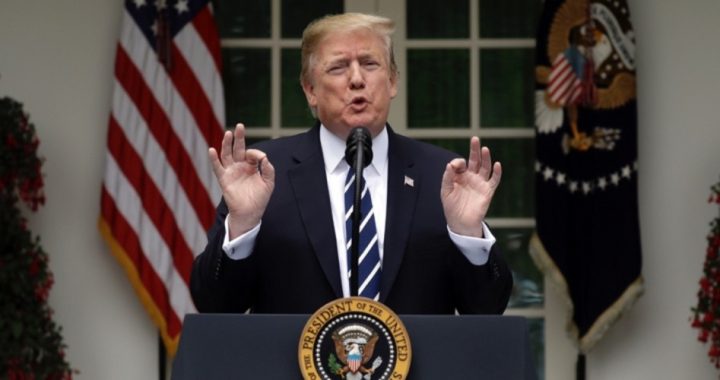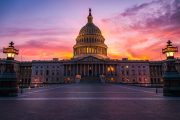
Yale Professor Ray Fair has been accurately predicting the outcomes of presidential elections — ignoring the polls — and he expects, based on the “model” that he has created, President Donald Trump is on his way to a huge victory in 2020.
What Professor Fair has concluded is that the growth rates of the gross domestic product (GDP) and price inflation, combined with incumbency, are the three most important factors in the outcome of presidential elections. In 2008, Fair forecast that Senator Barack Obama, the Democratic Party nominee, would take 53.1 percent of the popular vote between the two major party candidates. He actually captured 53.7 percent, after one only measures the votes between the Democratic and Republican nominees.
Then, in 2012, Fair predicted that Obama’s percentage of the vote, when compared with just Republican candidate Mitt Romney, would be 51.8 percent. When just the votes of Obama and Romney were counted, the actual percentage Obama received was 52 percent. (When other party candidates were included, Obama received 51 percent of the popular vote, the first incumbent president in U.S. history to be reelected with a smaller percentage of the popular vote than he received the first time).
In 2012, the economy’s recovery from the Great Recession of 2007-2008 was still rather weak, but Obama had the advantage of incumbency, Fair noted. It could also be added that Obama had the advantage of an almost-universal adoration of the mainstream media going for him.
The election of 2016, however, produced results that varied from the model. Trump should have taken 54.1 percent of the vote between just him and Democratic candidate Hillary Clinton, according to Fair’s model, but he only had 48.8 percent in the contest between the two major party candidates.
Steven Rattner, a counselor to the Treasury Department in the Obama administration, wrote in The New York Times, “I’m quite confident that the gap was a function of the generally unfavorable rankings on Mr. Trump’s personal qualities. In other words, a more “normal” Republican would likely have won the popular vote by a substantial margin (instead of losing it by three million votes).”
Rattner argued that “a good part” of Trump’s edge over Clinton in the 2016 contest was another factor in presidential contests — after eight years of one political party, voters are more likely to cast their ballots for the other major party candidate. At least, this has been the pattern since 1952, with the lone exception being 1988, when Republican nominee George H.W. Bush won after eight years of Republican President Ronald Reagan. (Most analysts have concluded that many voters were voting for a third term for Reagan when they voted for Bush).
In 2020, Trump will enjoy the benefit of incumbency, although he will also face unrelenting opposition from the mainstream liberal media. However, he faced that same opposition in 2016, and won anyway. To the consternation of that same media, despite daily negative coverage, they have not been able to make a significant dent in the support he has received since 2016. Part of that can be attributed to the “Good Watchdog” analogy. A good watchdog barks when something is wrong, but when the watchdog barks all the time, at some point it just becomes noise. That may be the case with Trump and the media. In other words, it is no longer news that the media does not like Trump, so the average person has simply tuned it out.
The models are predicting that Trump’s reelection numbers should be around 56 percent of the popular vote, but polling against potential Democratic nominee Joe Biden has Trump trailing by eight points, netting only 41 percent of the popular vote.
Fair is not the only person with a “model” predicting a Trump victory in 2020, however. After looking at 12 models, Mark Zandi, the chief economist for Moody’s Analytics, has concluded that Trump wins all of them. Another analyst, Donald Luskin of Trend Macrolytics, has also determined that Trump will win the Electoral College by a comfortable margin.
There are other factors, in addition to incumbency and the economy, that could play a role in the 2020 outcome, of course. No one can confidently predict what foreign-policy issues might affect the presidential contest. Then, when one considers “hot-button” issues such as abortion and gun control, most voters are set in their views, so swings on these issues tend to be quite small from one election to the next.
Abortion, however, could be a wild-card in 2020. With the recent push in some states to essentially legalize abortion up to birth, and with the Democratic candidates mostly supportive of that extreme position, voters who have been somewhat lukewarm on the abortion issue could swing to Trump.
Then there is the Supreme Court. It was clearly an issue that captured the attention of many voters in 2016, and will no doubt play a role in 2020. If one of the aging justices were to die or retire in the middle of the campaign, picking the president who will pick the successor will no doubt emerge as a huge factor in the race.
Democratic Party leaders are aware of these models, so we can expect them and their allies in the media to become even more shrill in the months ahead, realizing that the odds of them having to put up with another term of President Trump are increasing.
Photo: AP Images



